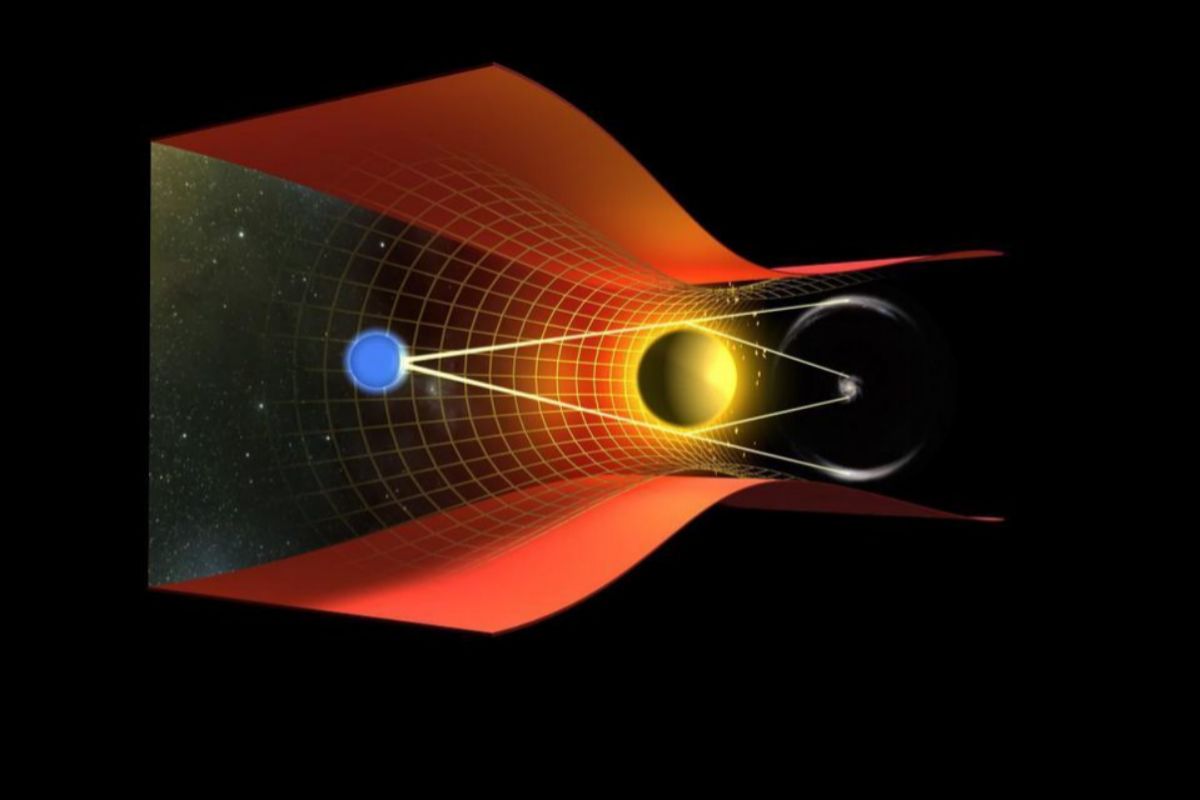- Chronicles of the cosmos: the mystery of extragalactic radio bursts grows
- Astronomy Hubble's 30th birthday: the telescope that changed our view of the cosmos
Using the giant ALMA radio telescope, astronomers have observed one of the most spectacular cases of the phenomenon known as the 'Einstein ring'.
Thus a galaxy similar to the Milky Way has been discovered, but at the astonishing distance of 12,000 million light years . That is, we now observe it as it was when the universe was only 10% of its current age. These measurements provide new clues to the early evolution of galaxies.
The largest telescope in the world
The largest lenses in the world are not built by humans. The most powerful telescopes are provided to us for free by the universe when two galaxies are in the same line of sight. We can then attend one of the most spectacular phenomena in nature : what is called a 'gravitational lens'.
This phenomenon is illustrated in the accompanying figure, in which the blue sphere represents the Earth and the orange sphere represents a nearby galaxy that is well aligned with the farthest spiral galaxy. Einstein's theory of general relativity predicts that the nearby galaxy distorts the lines of space-time, which is represented by the yellow mesh of its surroundings. The rays of light emitted by the distant galaxy are bent following this mesh that redirects them towards the Earth.
Observers on Earth will see a highly distorted image of the more distant galaxy : usually arcs of light around the image of the nearby galaxy.
It is a phenomenon similar to that which occurs when we observe a light through the bottom of a glass with liquid and see the distorted image of the light source. The nearest galaxy acts as a colossal lens that redirects the rays of light emitted behind to create a distorted image. It is a kind of gigantic telescope provided by nature itself .
If the two galaxies are perfectly aligned, the image of the distant galaxy formed by the lens is a ring of light centered on the neighboring galaxy. The phenomenon was predicted by Albert Einstein almost a century ago, which is why the circular figures that are formed are called 'Einstein rings'. Einstein himself considered it to be a very subtle phenomenon and doubted that a day could come when it would be observed , so he considered it a curiosity rather than a work tool.
However, thanks to the progress of astronomical observation, which could not be anticipated by Einstein, hundreds of gravitational lenses are known today. Many such lenses have the well-circular, though almost always incomplete, shape of Einstein's rings.
Quasi-perfect donut
Using the giant ALMA radio telescope located in the Atacama desert, a group of astronomers coordinated by Francesca Rizzo of the Max-Planck Institute for Astrophysics (Germany) has obtained the image of a very complete and very well delineated Einstein ring , one of the most perfect observed to date, shown in the image that heads this article. This is the system known as SPT0418-47.
In this system, the closest galaxy (not shown in the image) is about 3,000 million light years away, while the furthest, the one that gives rise to the Einstein ring, is located at the dizzying distance of 12,400 million. light years. This observation allows us, therefore, to see what a galaxy looked like when 1,400 million years had elapsed after the big bang, that is, when the universe was 10% of its current age.
The childhood of the galaxies
However, the most surprising thing about this observation is not the perfection of the Einstein ring, but the characteristics of the remote galaxy. Indeed, by studying the ring, astronomers are able to reconstruct the shape and characteristics of the more distant galaxy. They thus deduce that that galaxy must have properties and a structure similar to that of the Milky Way : a rotating disk and a large bulb of stars around the galactic center.
Until now it was thought that galaxies that were so remote and, therefore, observed at the beginning of their evolution, must be very turbulent and chaotic. However, several recent studies, including this one that we present in this section a few months ago, show that galaxies have a very short childhood, as they form well-structured rotating disks very quickly. In another remote galaxy called DLA0817g, studied by Neelman and colleagues ( Nature ) they also found a well-organized rotating disk that was called the Wolf disk. But the galaxy studied now contains possibly the best structured disk of those studied in the early universe.
Evidence continues to grow that the early universe was not as chaotic and turbulent as we believed until recently. All these observations make astronomers completely rethink the study of the evolution of galaxies like ours.
The results of Rizzo and colleagues have been published just a few days ago in the prestigious journal Nature .
Rafael Bachiller is director of the National Astronomical Observatory (National Geographic Institute) and academic of the Royal Academy of Doctors of Spain .
According to the criteria of The Trust Project
Know more- science
- Science and Health
AstronomyDelta Aquarids: the best time to see the meteor shower arrives tonight, July 30
NASA offers more than 150,000 euros to those who solve this problem before returning to the Moon
The incidence of the virus in Spain five times that of the United Kingdom
See links of interest
- News
- Translator
- Programming
- Calendar
- Horoscope
- Classification
- Films
- Cut notes
- Topics
- Styrian Grand Prix, live

